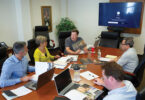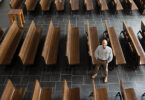Weakened restrictions called part of ‘incremental strategy’
——————————————————————————————————————
by Joe Bollig
joe.bollig@theleaven.org
After President Barack Obama lifted the ban on federal funding for embryonic stem-cell research on March 8, pro-life advocates waited for the other shoe to drop.
They didn’t have to wait long. In yet another late-Friday-afternoon announcement April 17, the National Institutes of Health released its draft guidelines for embryonic stem-cell research (ESCR).
Cardinal Justin Rigali, chairman of the U.S. Conference of Catholic Bishops Committee on Pro-Life Activities, criticized these guidelines for marking “a new chapter in divorcing biomedical research from its necessary ethical foundation.”
Although the draft guidelines do not offer as much latitude as pro-embryonic stem-cell research advocates want, pro-life advocates worry that the guidelines are “part of an incremental strategy intended to desensitize the public to the concept of killing human embryos for research,” according to a National Right- to-Life press release.
Their fears seem to be confirmed by James F. Battey Jr., vice chairman of the NIH stem-cell task force, who said that the president’s March 8 order includes periodic updates to the guidelines.
What happens next, however, may depend on what Congress does, said John Morris, an associate professor at Rockhurst University in Kansas City, Mo. Morris is a special adviser on stem-cell research to Bishop Robert W. Finn of the Diocese of Kansas City-St. Joseph.
“The [1996] Dickey-Wicker Amendment may limit the scope of [President Barack] Obama’s action because it prohibits the use of federal money for research that destroys human embryos,” said Morris, a member of Holy Cross Parish in Overland Park.
The amendment, however, must be renewed, he said. If it isn’t, the executive order would force taxpayers to support the production and destruction of embryos for stem-cell research.
“What is more likely is that this executive order will pull public funding away from ethical adult stem-cell research,” said Morris. “New avenues for research with adult stem cells are opening up all the time as we come to understand just how versatile [they] are — a reality that some scientists and politicians still refuse to acknowledge, despite the growing clinical evidence.”
Chasing the mirage
For years, proponents of ESCR have tantalized the public with talk about potential cures that are close, but just beyond reach — much like a dying man chasing a mirage across the desert.
“There has been a huge misperception in the public forum that numerous embryonic stem-cell therapies are waiting in the wings, ready to treat people,” said Morris. “This, however, is simply not the case.”
After more than 25 years, researchers have yet to treat even animals with embryonic stem cells (ESC) or to overcome three big, technical problems: difficulties in control, transplant rejection, and tumor formation.
The bottom line is that despite years of research in several countries, this un-ethical research hasn’t produced one single cure or treatment for humans, said Morris.
Nevertheless, the Food and Drug Administration has given permission to the Geron Corporation to conduct the first embryonic stem-cell trials on human patients in the United States.
“It appears that the FDA is fast-tracking this research, bypassing several levels of basic research protocols for work in humans,” said Morris. “Geron is being allowed to move directly from rodent studies to human patients. . . . Typically, more levels of higher animal trials are required before permission for phase I research is usually granted.”
A more promising path
Periodically, stories about another major advance in stem-cell research will be trumpeted in the media. Often, one has to read deeply into the story — or between the lines — to learn that these involve adult stem-cell research (ASCR), not ESCR.
“One study used adult stem-cells collected from liposuctioned fat,” said Morris. “Other studies have shown that you can harvest ACS directly from blood.”
“More recently, researchers have discovered a ‘cardiac’ stem cell which they believe will be even more effective for heart therapy, given that stem cells are derived from the heart muscle itself,” he continued. “In addition, tremendous progress is being made with umbilical cord blood stem cells, which have opened up brand new avenues of research and treatment.”
Don’t say the “C” word
When President Obama signed the executive order on March 8, many news outlets reported that he was against human cloning. Actually, he said he was against “reproductive” cloning.
“Because of the widespread opposition to human cloning, supporters of embryonic stem-cell research have taken to making a distinction between what they call ‘cloning for reproduction’ and ‘cloning for research,’” said Morris.
The difference between “reproductive” versus “therapeutic” (or cloning for research) is merely intent. With the former, the embryo would be implanted in a woman so a baby could be born. With the latter, the embryo would be destroyed for its stem cells.
Proponents of ESCR use these terms because most people are against human cloning. They also try to confuse people about somatic cell nuclear transfer, which is just the technical name for a cloning process.
Why the deception? Because if there is going to be extensive ESC research, there has to be cloning.
“The main reason for this is that cloning a person will give you genetically matched stem cells, so there should not be any tissue rejection if these cells are transplanted back into the patient who was cloned,” said Morris. “Under Obama’s decision, using embryos produced through cloning would be allowed. The only hindrance is the Dickey-Wicker Amendment.”
Not all about the science
Advocates of ESCR justify their research by saying no scientific avenue should be unexplored in the quest to relieve human suffering. They also claim that any impediment would be a blow to scientific freedom.
“But there are limits to what we, as a society, ought to do,” said Morris. “And the fact is that this science crosses ethical boundaries, so we cannot leave it solely up to the scientists.”
“We must all be involved in the debate over whether or not we want to allow or even be forced by this executive order,” he added, “to financially support the destruction of nascent human life, regardless of our goal.”
And there are other motivations for ESCR besides noble scientific discovery and compassionate care for sufferers: money.
“With embryonic stem-cell research, since the stem cells are derived from developing embryos, the stem-cell lines they hope to develop would be patentable and therefore would become the property of the researcher or doctor,” said Morris. “Plus, researchers will also be able to patent all of the techniques that would be required to make these cells safe.”
Where do we go from here?
Here’s what Catholics can do about ESCR, said Morris:
• Remain faithful to our commitment to the dignity of human life from conception to natural death. But this does not mean that we are insensitive to the suffering of those around us.
• Educate our communities about the differences between embryonic and adult stem-cell research.
• Inform others about the successes of adult stem-cell research, which the church supports. There are no ethical problems with adult stem-cell research. It is only embryonic stem-cell research, which has shown very little real promise, that the church opposes.
• Remind other members of society, including those in the scientific community, that there are limits to what we should do — the end does not justify the means.
“Even if embryonic stem-cell research were to show some success someday, it would still be unethical,” said Morris. “We simply cannot kill one innocent human life to try to save another. In this light, Catholics need to continue to be consistent and courageous supporters of the culture of life.”






